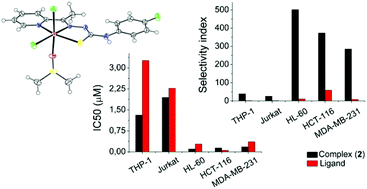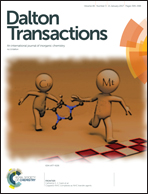Cytotoxic and antimicrobial effects of indium(iii) complexes with 2-acetylpyridine-derived thiosemicarbazones†
Abstract
Complexes [In(2Ac4oClPh)Cl2(MeOH)] (1), [In(2Ac4pFPh)Cl2(MeOH)] (2), [In(2Ac4pClPh)Cl2(MeOH)] (3) and [In(2Ac4pIPh)Cl2(MeOH)] (4) were obtained with N(4)-ortho-chlorophenyl-2-acetylpyridine thiosemicarbazone (H2Ac4oClPh), N(4)-para-fluorophenyl-2-acetylpyridine thiosemicarbazone (H2Ac4pFPh), N(4)-para-chlorophenyl-2-acetylpyridine thiosemicarbazone (H2Ac4pClPh) and N(4)-para-iodophenyl-2-acetylpyridine thiosemicarbazone (H2Ac4pIPh). Theoretical studies suggested that the coordinated methanol molecule can be easily replaced by DMSO used in the preparation of stock solutions, with the formation of [In(L)Cl2(DMSO)] (HL = thiosemicarbazonate ligand), and that the replacement of DMSO by water is unfavorable. However, for all complexes the displacement of one or two chloride ligands by water in aqueous solution is extremely favorable. The cytotoxic activity of the compounds was evaluated against HL-60, Jurkat and THP-1 leukemia and against MDA-MB-231 and HCT-116 solid tumor cell lines, as well as against Vero non-malignant cells. The cytotoxicity and selectivity indexes (SI) increased in several cases for the indium(III) complexes in comparison with the free thiosemicarbazones. The antimicrobial activity of the compounds was investigated against Candida albicans, Candida dubliniensis, Candida lusitaniae and Candida parapsilosis. In many cases complexation resulted in a substantial increase of the antifungal activity. Complexes (1–4) were revealed to be very active against C. lusitaniae and C. dubliniensis. Structure–activity relationship (SAR) studies were carried out to identify the physico-chemical properties that might be involved in the antifungal action, as well as in the cytotoxic effect of the compounds against HL-60 cells. In both cases, correlations between the bioactivity and physico-chemical properties did not appreciably change when the chloride ligands in [In(L)Cl2(DMSO)] were replaced by water molecules, suggesting [In(L)Cl(H2O)(DMSO)]+ or [In(L)(H2O)2(DMSO)]2+ to be the species that interact with the biological media.



 Please wait while we load your content...
Please wait while we load your content...